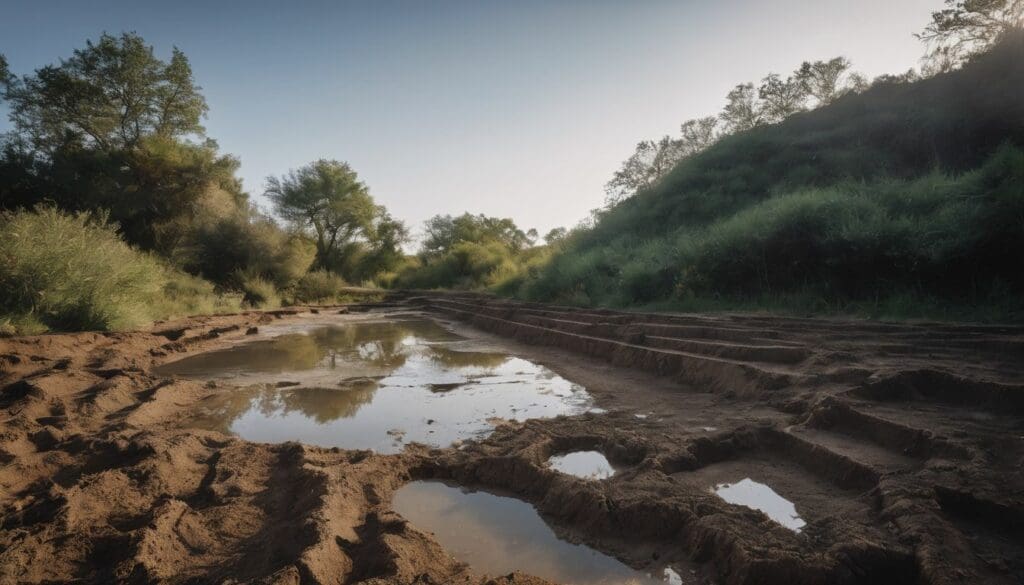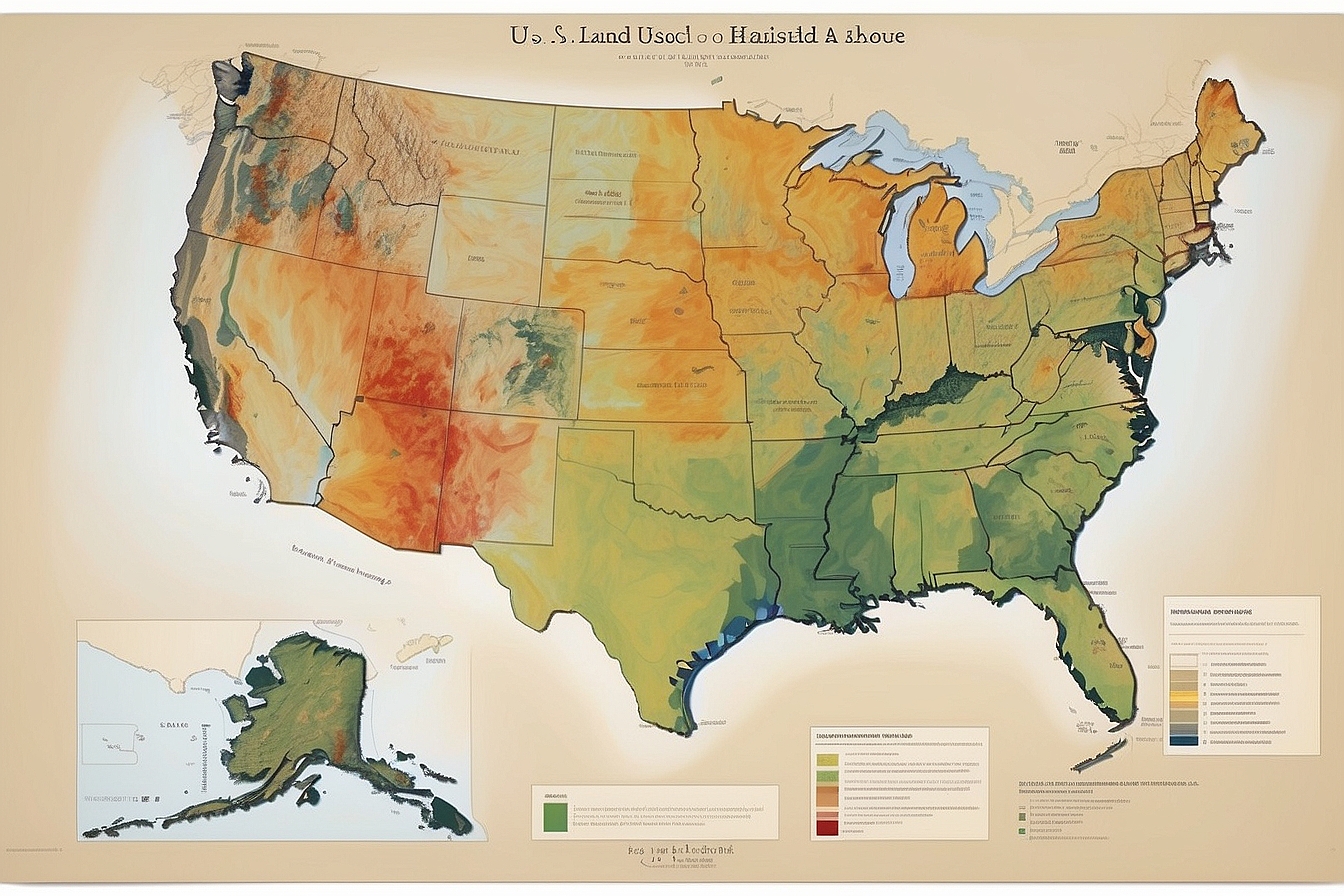Many of us have observed the telltale signs of trouble beneath our feet: cracks snaking through concrete pathways or gardens that undulate like a troubled sea, all hinting at the unseen adversary beneath – soil erosion.
This is a shared challenge for many homeowners across Northern Virginia, as we’ve discovered in our own neighbourhoods. Driven by this common plight, we’ve taken it upon ourselves to investigate the underlying causes and devise practical solutions.
Our forthcoming article will provide insight into how soil erosion can compromise the very foundations of your home and present you with effective measures to ensure your patch of earth remains firm.
Prepare to delve into the depths as we explore together!
Key Takeaways
- Soil erosion is caused by agricultural activities, deforestation, overgrazing, and the use of agrochemicals which strip away fertile topsoil and damage ecosystems.
- The removal of soil can lead to foundational issues in buildings such as instability and cracks, resulting in expensive repairs for homeowners.
- Preventing soil erosion involves sustainable land – use practices like barrier construction, strategic grading and landscaping, planting vegetation with deep roots to stabilise soil, and regular maintenance checks.
Causes of Soil Erosion
Agricultural practices, deforestation, overgrazing, and the use of agrochemicals are all contributing factors to soil erosion. These activities can lead to the loss of topsoil through water runoff and wind erosion.
Agriculture
We see agriculture as a vital source of food and livelihood, but it’s also a significant factor in soil erosion. Farming practices often disturb the soil surface, making it easy for wind and water to whisk away the fertile top layer.
We plow fields, remove crop residues and rely on monocultures; these actions can leave soil bare and exposed to erosion forces. Without protective cover or diverse plant roots that bind the earth together, precious topsoil gets lost.
Our practices sometimes contribute to land degradation too. Over time, intensive farming removes key nutrients from the soil without replenishing them adequately. This leads to reduced fertility and increased vulnerability to eroding forces.
To maintain our agricultural sustainability, we must embrace erosion control methods like contour plowing and conservative tillage that keep our soils where they belong – under our feet and giving life to crops.
Deforestation
Deforestation contributes significantly to soil erosion. The removal of trees and plants exposes the topsoil to the elements, leading to increased runoff and reduced water absorption.
This results in soil degradation, loss of nutrients, and decreased stability around foundations. Without the root systems of trees and plants to hold the soil together, it becomes vulnerable to erosion by wind and water.
As trees are removed during deforestation, their ability to absorb excess rainwater also diminishes. This can lead to increased flooding downstream as well as sedimentation in rivers and streams.
Overgrazing
After discussing the impact of deforestation on soil erosion, we also need to consider overgrazing as a significant factor contributing to this issue. Overgrazing occurs when livestock or animals consume vegetation at a faster rate than it can naturally regrow.
This leads to the depletion of plant cover and exposes the soil surface, making it more susceptible to erosion by wind and water.
Overgrazing not only reduces vegetation cover but also damages plant roots, lowering their ability to hold the soil together. As a result, topsoil becomes destabilised and is easily washed away during rainfall or blown away by wind, leading to soil erosion and loss of fertile topsoil.
Use of Agrochemicals
The use of agrochemicals, such as fertilisers and pesticides, can contribute to soil erosion. These chemicals disrupt the natural balance of the soil ecosystem, leading to a decline in soil structure and fertility.
Excessive use of agrochemicals also increases water runoff, which further accelerates erosion and contributes to topsoil loss. Sustainable farming practices that reduce reliance on agrochemicals can help preserve the integrity of our soils for future generations.
By minimising the use of agrochemicals and adopting alternative methods like crop rotation and organic pest control, we can promote healthier soils and mitigate the negative impacts of erosion on our environment.
Impacts of Soil Erosion on Foundations
Soil erosion can lead to foundation failure, soil displacement, costly repairs, and structural damage. Discover how to prevent these impacts by reading more.
Foundation failure
Soil erosion poses a significant threat to foundation stability. This problem can lead to foundation failure, compromising the structural integrity of buildings and homes. When erosion occurs, it causes soil displacement around the foundations, which undermines their support system and can result in costly repairs.
It is crucial to address soil erosion around foundations through proactive measures such as sustainable land use, building barriers, grading and landscaping, use of vegetation, and regular maintenance.
Preserving topsoil and preventing its displacement are essential for maintaining the stability of foundations against the destructive impact of erosion. Without effective measures in place, the risk of foundation failure due to soil erosion remains a pressing concern for homeowners and environmental conservationists alike.
Soil displacement
Soil displacement occurs when the top layer of soil is gradually removed or shifted due to external forces such as water, wind, or human activities. This can lead to the destabilisation of the ground around foundations, posing a risk for structural integrity.
To prevent soil displacement around foundations, implementing measures like sustainable landscaping and vegetation cover plays a crucial role in minimising erosion and maintaining the stability of the surrounding soil.
Considering environmental conservation strategies in home landscaping and construction projects is essential to prevent topsoil erosion and preserve the foundation’s strength over time.
Costly repairs
Repairing the damage caused by soil displacement can result in expensive repairs for homeowners. Replacing eroded topsoil, repairing structural foundations, and fixing landscaping can all add up to significant costs.
These repairs not only impact your wallet but also contribute to a larger environmental problem. Preventing soil erosion is crucial in avoiding these costly repairs.
When foundation failures and structural damages occur due to soil erosion, it’s important to remember that the financial burden falls on homeowners. Taking proactive steps towards preventing soil erosion can help conserve both resources and finances in the long run.
Structural damage
Structural damage occurs when soil erosion weakens the foundation, leading to cracks and instability in buildings. The shifting soil can cause structural elements to sink or become uneven, impacting the overall integrity of the construction.
These issues often result in costly repairs and pose safety concerns for inhabitants.
To prevent structural damage from soil erosion, it’s crucial to employ effective erosion prevention methods such as sustainable land use, building barriers, grading and landscaping techniques, utilisation of vegetation cover, and regular maintenance.
By implementing these strategies, we can safeguard our foundations from potential harm caused by soil displacement and degradation.
Ways to Prevent Soil Erosion Around Foundations
There are several ways to prevent soil erosion around foundations, including sustainable land use practices, building barriers to redirect water flow, grading and landscaping to control runoff, using vegetation for stabilisation, and regular maintenance to address any signs of erosion.
These methods can help protect the integrity of our foundations and preserve the topsoil from being lost or displaced.
Sustainable land use
To prevent soil erosion around foundations, we advocate for sustainable land use. This involves employing techniques that prioritise the conservation of topsoil and promote its preservation through responsible agricultural practices, watershed management, and reforestation efforts.
By embracing sustainable land use methods, we can protect our environment, mitigate desertification risks, and ensure the longevity of our Northern Virginia homes’ foundations.
Implementing sustainable land use practices also supports the prevention of costly repairs due to soil displacement while promoting a healthier ecosystem overall. We encourage the use of vegetation cover and effective grading and landscaping to minimise runoff and subsequent soil loss.
Building barriers
To prevent soil erosion around foundations, we construct barriers like retaining walls or concrete pavement. These structures help to hold back the soil and prevent displacement, preserving the topsoil from being washed away by rainfall.
By creating physical barriers, we can protect our foundations and keep the surrounding land intact.
When using vegetation as a barrier, it is essential to choose plants with deep roots that can anchor the soil effectively. This helps in preventing erosion and maintaining a healthy topsoil layer around our foundations.
Grading and landscaping
After establishing effective barriers to prevent soil erosion around foundations, the next crucial step is grading and landscaping. This process involves shaping the land to direct water flow away from the foundation, thus preventing soil displacement.
By creating a slope away from the building and strategically placing plants and vegetation, we can significantly reduce the impact of water on the soil and ultimately preserve our topsoil.
Additionally, effective grading and landscaping not only prevent topsoil erosion but also contribute to a visually appealing environment while supporting sustainable land use. Hence, incorporating this method alongside other preventive measures plays a vital role in conserving our soil for future generations.
Use of vegetation
Vegetation plays a crucial role in preventing soil erosion around foundations. Planting trees, shrubs, and ground cover helps to hold the soil together, reducing the impact of raindrops on the ground.
The roots of vegetation also create channels for water to flow through, promoting infiltration and reducing surface runoff, which ultimately prevents topsoil from being washed away.
In addition to stabilising the soil, vegetation creates a protective barrier against wind and water erosion. By acting as a natural shield, it reduces the force of rainfall on the ground and minimises wind velocity near the foundation.
Regular maintenance
Transitioning from the use of vegetation to regular maintenance is crucial for preserving topsoil around foundations. Regular maintenance involves inspecting, repairing, and managing landscaping elements to prevent soil erosion.
It includes routine checks for any signs of erosion, such as exposed roots or bare patches, and taking prompt action to rectify them.
Furthermore, maintaining proper drainage systems and diverting water away from the foundation can significantly reduce soil erosion risks. Periodic mulching and reseeding in landscaped areas also contribute to stabilising the topsoil by preventing runoff.
Conclusion
In conclusion, preventing soil erosion around foundations is crucial for maintaining the integrity of our structures. Implementing sustainable land use practices and building barriers can effectively protect against topsoil loss.
Incorporating vegetation and regular maintenance further aids in preserving our foundation’s stability. It’s essential to take proactive measures to safeguard against the detrimental impacts of soil erosion on our built environment.
FAQs
1. What is soil erosion and why is it a threat?
Soil erosion happens when the top layer of soil is worn away, mainly by wind or water, which is a danger as it carries away rich topsoil essential for plants to grow.
2. How can we prevent topsoil erosion?
We can prevent topsoil erosion by using methods like planting trees that hold the soil together with their roots and building terraces on slopes.
3. Why do we need to preserve our topsoil?
Preserving our topsoil matters because it contains nutrients that plants require to flourish—without healthy soil, crops wouldn’t thrive.
4. What actions can contribute towards soil conservation?
Taking steps such as reducing ploughing in fields, conserving natural vegetation around farmlands, and managing water drainage effectively are all beneficial for soil conservation.





